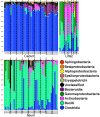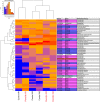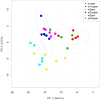Temporal Relationships Exist Between Cecum, Ileum, and Litter Bacterial Microbiomes in a Commercial Turkey Flock, and Subtherapeutic Penicillin Treatment Impacts Ileum Bacterial Community Establishment
- PMID: 26664983
- PMCID: PMC4672264
- DOI: 10.3389/fvets.2015.00056
Temporal Relationships Exist Between Cecum, Ileum, and Litter Bacterial Microbiomes in a Commercial Turkey Flock, and Subtherapeutic Penicillin Treatment Impacts Ileum Bacterial Community Establishment
Abstract
Gut health is paramount for commercial poultry production, and improved methods to assess gut health are critically needed to better understand how the avian gastrointestinal tract matures over time. One important aspect of gut health is the totality of bacterial populations inhabiting different sites of the avian gastrointestinal tract, and associations of these populations with the poultry farm environment, since these bacteria are thought to drive metabolism and prime the developing host immune system. In this study, a single flock of commercial turkeys was followed over the course of 12 weeks to examine bacterial microbiome inhabiting the ceca, ileum, and corresponding poultry litter. Furthermore, the effects of low-dose, growth-promoting penicillin treatment (50 g/ton) in feed on the ileum bacterial microbiome were also examined during the early brood period. The cecum and ileum bacterial communities of turkeys were distinct, yet shifted in parallel to one another over time during bird maturation. Corresponding poultry litter was also distinct yet more closely represented the ileal bacterial populations than cecal bacterial populations, and also changed parallel to ileum bacterial populations over time. Penicillin applied at low dose in feed significantly enhanced early weight gain in commercial poults, and this correlated with predictable shifts in the ileum bacterial populations in control versus treatment groups. Overall, this study identified the dynamics of the turkey gastrointestinal microbiome during development, correlations between bacterial populations in the gastrointestinal tract and the litter environment, and the impact of low-dose penicillin on modulation of bacterial communities in the ileum. Such modulations provide a target for alternatives to low-dose antibiotics.
Keywords: Turkey; antibiotic; avian; bacteria; growth promoter; microbiome; penicillin; poultry.
Figures






References
-
- National Agricultural Statistics Service. Turkeys Raised. United States Department of Agriculture Economics, Statistics and Market Information System. (2012). Available at: https://usda.mannlib.cornell.edu/MannUsda/viewDocumentInfo.do?documentID...
-
- Calvert A. Light Turkey Syndrome: Field Study and Inoculation Trial. M S thesis, Department of Animal Science, University of Minnesota, Saint Paul, MN, USA: (2012).
Grants and funding
LinkOut - more resources
Full Text Sources
Other Literature Sources

